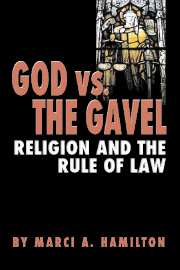Book contents
- Frontmatter
- Contents
- Acknowledgments
- Foreword, by the Hon. Edward R. Becker
- GOD VS. THE GAVEL: RELIGION AND THE RULE OF LAW
- PART ONE WHY THE LAW MUST GOVERN RELIGIOUS ENTITIES
- 1 The Problem
- 2 Children
- 3 Marriage
- 4 Religious Land Use and Residential Neighborhoods
- 5 Schools
- 6 The Prisons and the Military
- 7 Discrimination
- PART TWO THE HISTORY AND DOCTRINE BEHIND THE RULE THAT SUBJECTS RELIGIOUS ENTITIES TO DULY ENACTED LAWS
- Epilogue
- Notes
- Index
4 - Religious Land Use and Residential Neighborhoods
Published online by Cambridge University Press: 24 July 2009
- Frontmatter
- Contents
- Acknowledgments
- Foreword, by the Hon. Edward R. Becker
- GOD VS. THE GAVEL: RELIGION AND THE RULE OF LAW
- PART ONE WHY THE LAW MUST GOVERN RELIGIOUS ENTITIES
- 1 The Problem
- 2 Children
- 3 Marriage
- 4 Religious Land Use and Residential Neighborhoods
- 5 Schools
- 6 The Prisons and the Military
- 7 Discrimination
- PART TWO THE HISTORY AND DOCTRINE BEHIND THE RULE THAT SUBJECTS RELIGIOUS ENTITIES TO DULY ENACTED LAWS
- Epilogue
- Notes
- Index
Summary
Religious landowners face daunting needs for buildings and property, which means their residential neighbors are often affected by their plans. The worship space needs to be large enough to accommodate weekly gatherings of a significant percentage of their members and even bigger assemblies for holidays. Thus, a small building with minimal parking is ordinarily not adequate to the task. In the era when these buildings were only used for worship and maybe a choir practice, despite their size, houses of worship were attractive residential neighbors. Church properties were like miniature parks of peaceful tranquility in residential neighborhoods – the grounds were pretty, the building was tasteful, and they were excellent neighbors. Parking, traffic, lights, and noise were not typical problems. That is no longer true.
The paradigm shift in houses of worship
There has been a paradigm shift in houses of worship in the United States. Unfortunately for their neighbors, although favorable for the recipients of their services, contemporary houses of worship are not the sleepy institutions they once were. They are now a locus for social services, as well as a center for worship and entertainment. The thriving religious entities have sizeable buildings, with seating for hundreds – maybe thousands, along with heavy traffic, intense parking needs, and even bus transportation into the neighborhood from off site. If they are starting from scratch, they usually (though not always) search for a large parcel of land that is along a major thoroughfare.
- Type
- Chapter
- Information
- God vs. the GavelReligion and the Rule of Law, pp. 78 - 110Publisher: Cambridge University PressPrint publication year: 2005

